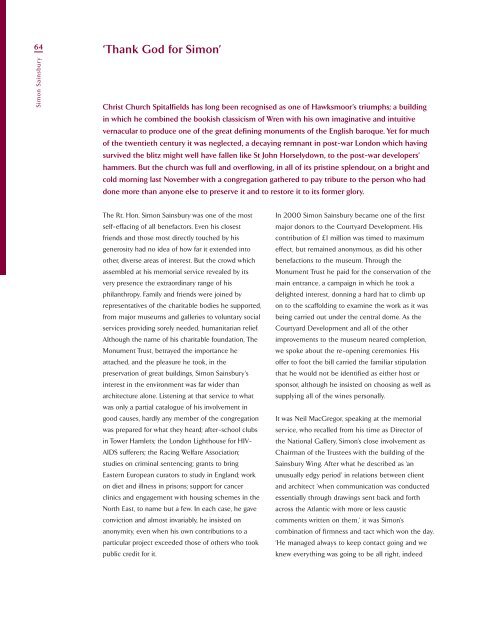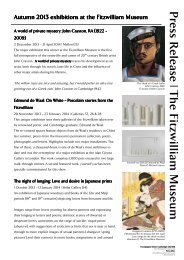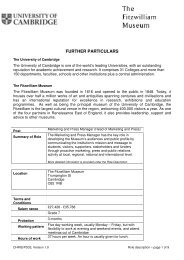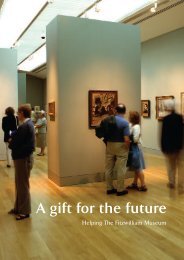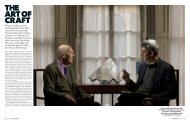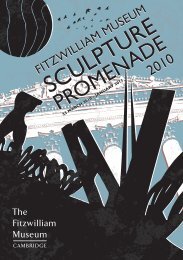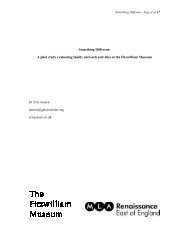The Fitzwilliam Museum - University of Cambridge
The Fitzwilliam Museum - University of Cambridge
The Fitzwilliam Museum - University of Cambridge
Create successful ePaper yourself
Turn your PDF publications into a flip-book with our unique Google optimized e-Paper software.
64<br />
Simon Sainsbury<br />
‘Thank God for Simon’<br />
Christ Church Spitalfields has long been recognised as one <strong>of</strong> Hawksmoor’s triumphs; a building<br />
in which he combined the bookish classicism <strong>of</strong> Wren with his own imaginative and intuitive<br />
vernacular to produce one <strong>of</strong> the great defining monuments <strong>of</strong> the English baroque. Yet for much<br />
<strong>of</strong> the twentieth century it was neglected, a decaying remnant in post-war London which having<br />
survived the blitz might well have fallen like St John Horselydown, to the post-war developers’<br />
hammers. But the church was full and overflowing, in all <strong>of</strong> its pristine splendour, on a bright and<br />
cold morning last November with a congregation gathered to pay tribute to the person who had<br />
done more than anyone else to preserve it and to restore it to its former glory.<br />
<strong>The</strong> Rt. Hon. Simon Sainsbury was one <strong>of</strong> the most<br />
self-effacing <strong>of</strong> all benefactors. Even his closest<br />
friends and those most directly touched by his<br />
generosity had no idea <strong>of</strong> how far it extended into<br />
other, diverse areas <strong>of</strong> interest. But the crowd which<br />
assembled at his memorial service revealed by its<br />
very presence the extraordinary range <strong>of</strong> his<br />
philanthropy. Family and friends were joined by<br />
representatives <strong>of</strong> the charitable bodies he supported,<br />
from major museums and galleries to voluntary social<br />
services providing sorely needed, humanitarian relief.<br />
Although the name <strong>of</strong> his charitable foundation, <strong>The</strong><br />
Monument Trust, betrayed the importance he<br />
attached, and the pleasure he took, in the<br />
preservation <strong>of</strong> great buildings, Simon Sainsbury’s<br />
interest in the environment was far wider than<br />
architecture alone. Listening at that service to what<br />
was only a partial catalogue <strong>of</strong> his involvement in<br />
good causes, hardly any member <strong>of</strong> the congregation<br />
was prepared for what they heard; after-school clubs<br />
in Tower Hamlets; the London Lighthouse for HIV-<br />
AIDS sufferers; the Racing Welfare Association;<br />
studies on criminal sentencing; grants to bring<br />
Eastern European curators to study in England; work<br />
on diet and illness in prisons; support for cancer<br />
clinics and engagement with housing schemes in the<br />
North East, to name but a few. In each case, he gave<br />
conviction and almost invariably, he insisted on<br />
anonymity, even when his own contributions to a<br />
particular project exceeded those <strong>of</strong> others who took<br />
public credit for it.<br />
In 2000 Simon Sainsbury became one <strong>of</strong> the first<br />
major donors to the Courtyard Development. His<br />
contribution <strong>of</strong> £1 million was timed to maximum<br />
effect, but remained anonymous, as did his other<br />
benefactions to the museum. Through the<br />
Monument Trust he paid for the conservation <strong>of</strong> the<br />
main entrance, a campaign in which he took a<br />
delighted interest, donning a hard hat to climb up<br />
on to the scaffolding to examine the work as it was<br />
being carried out under the central dome. As the<br />
Courtyard Development and all <strong>of</strong> the other<br />
improvements to the museum neared completion,<br />
we spoke about the re-opening ceremonies. His<br />
<strong>of</strong>fer to foot the bill carried the familiar stipulation<br />
that he would not be identified as either host or<br />
sponsor, although he insisted on choosing as well as<br />
supplying all <strong>of</strong> the wines personally.<br />
It was Neil MacGregor, speaking at the memorial<br />
service, who recalled from his time as Director <strong>of</strong><br />
the National Gallery, Simon’s close involvement as<br />
Chairman <strong>of</strong> the Trustees with the building <strong>of</strong> the<br />
Sainsbury Wing. After what he described as ‘an<br />
unusually edgy period’ in relations between client<br />
and architect ‘when communication was conducted<br />
essentially through drawings sent back and forth<br />
across the Atlantic with more or less caustic<br />
comments written on them,’ it was Simon’s<br />
combination <strong>of</strong> firmness and tact which won the day.<br />
‘He managed always to keep contact going and we<br />
knew everything was going to be all right, indeed


